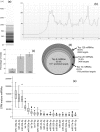Human Breast Milk miRNA, Maternal Probiotic Supplementation and Atopic Dermatitis in Offspring
- PMID: 26657066
- PMCID: PMC4682386
- DOI: 10.1371/journal.pone.0143496
Human Breast Milk miRNA, Maternal Probiotic Supplementation and Atopic Dermatitis in Offspring
Abstract
Background: Perinatal probiotic ingestion has been shown to prevent atopic dermatitis (AD) in infancy in a number of randomised trials. The Probiotics in the Prevention of Allergy among Children in Trondheim (ProPACT) trial involved a probiotic supplementation regime given solely to mothers in the perinatal period and demonstrated a ~40% relative risk reduction in the cumulative incidence of AD at 2 years of age. However, the mechanisms behind this effect are incompletely understood. Micro-RNAs (miRNA) are abundant in mammalian milk and may influence the developing gastrointestinal and immune systems of newborn infants. The objectives of this study were to describe the miRNA profile of human breast milk, and to investigate breast milk miRNAs as possible mediators of the observed preventative effect of probiotics.
Methods: Small RNA sequencing was conducted on samples collected 3 months postpartum from 54 women participating in the ProPACT trial. Differential expression of miRNA was assessed for the probiotic vs placebo and AD vs non-AD groups. The results were further analysed using functional prediction techniques.
Results: Human breast milk samples contain a relatively stable core group of highly expressed miRNAs, including miR-148a-3p, miR-22-3p, miR-30d-5p, let-7b-5p and miR-200a-3p. Functional analysis of these miRNAs revealed enrichment in a broad range of biological processes and molecular functions. Although several miRNAs were found to be differentially expressed on comparison of the probiotic vs placebo and AD vs non-AD groups, none had an acceptable false discovery rate and their biological significance in the development of AD is not immediately apparent from their predicted functional consequences.
Conclusion: Whilst breast milk miRNAs have the potential to be active in a diverse range of tissues and biological process, individual miRNAs in breast milk 3 months postpartum are unlikely to play a major role in the prevention of atopic dermatitis in infancy by probiotics ingestion in the perinatal period.
Trial registration: ClinicalTrials.gov NCT00159523.
Conflict of interest statement
Figures


Similar articles
-
Perinatal probiotic supplementation in the prevention of allergy related disease: 6 year follow up of a randomised controlled trial.BMC Dermatol. 2015 Aug 1;15:13. doi: 10.1186/s12895-015-0030-1. BMC Dermatol. 2015. PMID: 26232126 Free PMC article. Clinical Trial.
-
Atopic dermatitis prevention in children following maternal probiotic supplementation does not appear to be mediated by breast milk TSLP or TGF-β.Clin Transl Allergy. 2016 Jul 22;6:27. doi: 10.1186/s13601-016-0119-6. eCollection 2016. Clin Transl Allergy. 2016. PMID: 27453775 Free PMC article.
-
Reduced Th22 cell proportion and prevention of atopic dermatitis in infants following maternal probiotic supplementation.Clin Exp Allergy. 2017 Aug;47(8):1014-1021. doi: 10.1111/cea.12930. Epub 2017 Apr 21. Clin Exp Allergy. 2017. PMID: 28346719 Clinical Trial.
-
Probiotic Supplementation for Prevention of Atopic Dermatitis in Infants and Children: A Systematic Review and Meta-analysis.Am J Clin Dermatol. 2019 Jun;20(3):367-377. doi: 10.1007/s40257-018-0404-3. Am J Clin Dermatol. 2019. PMID: 30465329
-
Non-Coding RNAs in Human Breast Milk: A Systematic Review.Front Immunol. 2021 Sep 1;12:725323. doi: 10.3389/fimmu.2021.725323. eCollection 2021. Front Immunol. 2021. PMID: 34539664 Free PMC article.
Cited by
-
Human milk extracellular vesicle miRNA expression and associations with maternal characteristics in a population-based cohort from the Faroe Islands.Sci Rep. 2021 Mar 12;11(1):5840. doi: 10.1038/s41598-021-84809-2. Sci Rep. 2021. PMID: 33712635 Free PMC article.
-
Immunomodulatory Properties of Human Breast Milk: MicroRNA Contents and Potential Epigenetic Effects.Biomedicines. 2022 May 24;10(6):1219. doi: 10.3390/biomedicines10061219. Biomedicines. 2022. PMID: 35740242 Free PMC article. Review.
-
Recent Advances on the Function and Purification of Milk Exosomes: A Review.Front Nutr. 2022 Jun 9;9:871346. doi: 10.3389/fnut.2022.871346. eCollection 2022. Front Nutr. 2022. PMID: 35757254 Free PMC article. Review.
-
Identification of important extracellular vesicle RNA molecules related to sperm motility and prostate cancer.Extracell Vesicles Circ Nucl Acids. 2021 Apr 8;2(2):104-126. doi: 10.20517/evcna.2021.02. eCollection 2021. Extracell Vesicles Circ Nucl Acids. 2021. PMID: 39697534 Free PMC article.
-
Milk exosomal miRNAs: potential drivers of AMPK-to-mTORC1 switching in β-cell de-differentiation of type 2 diabetes mellitus.Nutr Metab (Lond). 2019 Dec 6;16:85. doi: 10.1186/s12986-019-0412-1. eCollection 2019. Nutr Metab (Lond). 2019. PMID: 31827573 Free PMC article.
References
-
- Agarwal S, Karmaus W, Davis S, Gangur V. Immune markers in breast milk and fetal and maternal body fluids: a systematic review of perinatal concentrations. J Hum Lact. 2011;27(2):171–86. - PubMed
-
- Patelarou E, Girvalaki C, Brokalaki H, Patelarou A, Androulaki Z, Vardavas C. Current evidence on the associations of breastfeeding, infant formula, and cow's milk introduction with type 1 diabetes mellitus: a systematic review. Nutr Rev. 2012;70(9):509–19. 10.1111/j.1753-4887.2012.00513.x - DOI - PubMed
-
- Davis MK. Breastfeeding and chronic disease in childhood and adolescence. Pediatr Clin North Am. 2001;48(1):125–41, ix. - PubMed
Publication types
MeSH terms
Substances
Associated data
LinkOut - more resources
Full Text Sources
Other Literature Sources
Medical

